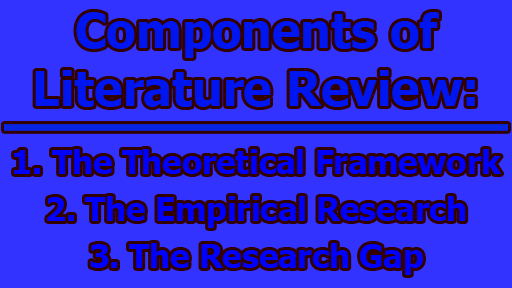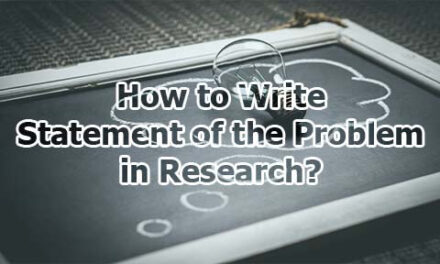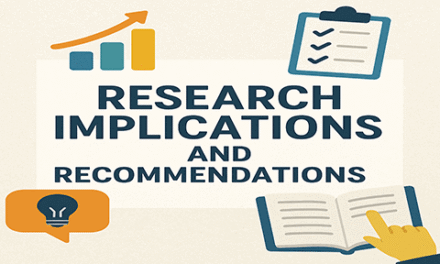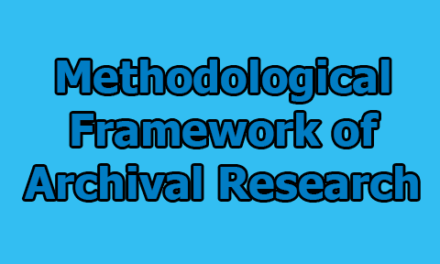Components of Literature Review:
Constructing a comprehensive and concise literature review demands careful attention and precision. Navigating the vast sea of information and determining its significance can be a complex task. This article aims to delve into three fundamental components that are indispensable to a well-structured literature review. By understanding and adeptly incorporating components of literature review, you can establish a robust foundation for your research.
1. The Theoretical Framework: Let’s begin by examining the first essential component – the theoretical framework, also known as the foundation of theory. The theoretical framework marks the inception of your literature review, serving as the cornerstone upon which your study’s conceptual framework is built. It’s important to distinguish between the theoretical framework and the conceptual framework, as they serve distinct purposes.
Within the theoretical framework, several pivotal aspects need attention:
a. Definition of Key Constructs and Variables: This involves offering precise definitions of the central terms and variables in your study. Addressing potential ambiguities in interpretation and explaining your chosen definitions is essential. Additionally, discussing underlying assumptions and justifying their relevance to your study is crucial.
b. Interrelationships Between Variables and Constructs: Exploring the relationships among variables and constructs is another critical facet. This unveils the connections between different elements, providing a comprehensive understanding of your research.
c. Relevant Existing Theories: Your theoretical framework should encompass a discussion of existing theories that align with your research objectives and questions. Introducing these theories and explaining how they shape your study’s direction demonstrates their influence on your research.
2. The Empirical Research: The second essential component is the empirical research section. This component involves a thorough analysis of existing empirical studies that pertain to your research objectives and questions. Empirical research encompasses studies that involve real-world data collection and analysis, encompassing both qualitative and quantitative methodologies. This differs from theoretical literature, which derives conclusions from logical reasoning rather than empirical evidence.
A comprehensive analysis of existing empirical research goes beyond mere summarization. It necessitates a critical examination that addresses key questions:
a. Variability in Findings: Investigate the findings of different studies in relation to your research questions. Do consistent outcomes emerge, or do discrepancies exist? Identifying patterns in findings helps establish the current knowledge landscape.
b. Contextual Considerations: Explore the contexts covered by prior research. Are there specific geographical areas, cultural contexts, or demographics that remain unexplored? Identifying these gaps highlights areas where further investigation is needed.
c. Methodologies Employed: Analyze the methodologies employed in earlier studies. How can these methodologies inform your own research approach? Understanding the strengths and limitations of different methodologies is crucial for refining your study’s methodology.
d. Limitations and Discrepancies: Critically assess the limitations of previous studies. Recognizing these limitations sheds light on areas where your research can contribute significantly.
3. The Research Gap: The third vital component is the exploration of the research gap. This refers to unexplored or inadequately addressed areas within the existing body of academic knowledge. A research gap emerges when uncertainties or unresolved questions persist on specific topics or issues.
Identifying a research gap involves synthesizing the information discussed in the theoretical framework and empirical research sections:
a. Conflicting Findings: Discrepancies or conflicting findings in empirical studies can signal areas where clarity is needed. If different studies yield inconsistent results, this highlights the need for further investigation.
b. Unexplored Contexts: Recognize contexts that have been insufficiently covered in existing research. If certain geographical regions, cultural groups, or demographics have been overlooked, these gaps present opportunities for new insights.
c. Theoretical Ambiguities: Ambiguities or unanswered questions within existing theories can indicate gaps in understanding. Addressing these ambiguities through your research contributes to filling these gaps.
The identification of a research gap serves as the driving force behind your study. Your literature review highlights areas of limited knowledge or unresolved questions, establishing the foundation for your research to address these gaps.
In conclusion, a strong literature review relies on three important components; the theoretical framework, empirical research, and research gap. The theoretical framework sets up the main ideas, explains key terms, and talks about existing theories. Empirical research looks at real-world studies and figures out what patterns or gaps there are. But the most important part is the research gap – it’s like finding missing pieces in a puzzle. By combining these three parts, your literature review helps your research make sense, shows what other people have found, and explains why your research is important.
Frequently Asked Questions [FAQs]:
What is a literature review?
A literature review is a comprehensive and critical summary of existing research and knowledge on a specific topic. It involves analyzing, evaluating, and synthesizing relevant sources to provide an overview of what has been studied, what gaps exist, and what areas need further exploration.
Why is a literature review important?
A literature review serves as the foundation for your research by helping you understand the current state of knowledge, identifying gaps or unanswered questions, and justifying the need for your study. It demonstrates your familiarity with existing research and guides your research direction.
How do I choose sources for my literature review?
Select sources that are credible, relevant, and recent. Academic journals, books, conference proceedings, and reputable websites can be good sources. Make sure to include a mix of primary research studies, theoretical frameworks, and expert opinions.
What is the difference between a theoretical framework and a conceptual framework?
A theoretical framework is a structure of theories and concepts that underpin your study, while a conceptual framework is a visual representation of how these theories and concepts interact. Theoretical frameworks explain what you’re investigating, while conceptual frameworks show how variables are related.
How do I identify a research gap?
Research gaps are areas where there’s limited or conflicting information in the existing literature. You can identify them by looking for inconsistencies in findings, unexplored contexts, or unresolved questions. These gaps form the basis for your research’s significance.
How do I organize my literature review?
There are different ways to structure a literature review. Common approaches include chronological (by publication date), thematic (by topic or theme), and methodological (by research methods). Choose a structure that best fits your research goals.
Can I include my opinions in a literature review?
A literature review should be objective and focused on summarizing existing research. While you can provide critical analysis and interpretations of the sources, personal opinions should be minimized. The goal is to present a balanced overview of the literature.
How do I cite sources in my literature review?
Follow the citation style required by your academic institution or publisher. Common styles include APA, MLA, and Chicago. Make sure to properly attribute all ideas, data, and information that you’ve borrowed from other sources.
How do I know when my literature review is complete?
A literature review is never truly “complete” as research is ongoing. However, your review should cover the key studies, theories, and concepts relevant to your research. It should address your research objectives, present a clear research gap, and provide the context for your study.
Can I use old sources in my literature review?
While some classic sources might provide foundational information, it’s generally recommended to prioritize recent sources. This ensures that your literature review reflects the most current state of knowledge in your field.

Assistant Teacher at Zinzira Pir Mohammad Pilot School and College










